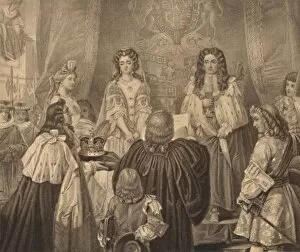William Iii Of England Collection (#3)
"William III of England: A Legacy Carved in History" From his decisive victory at the Battle of the Boyne to his enduring influence on English politics
All Professionally Made to Order for Quick Shipping
"William III of England: A Legacy Carved in History" From his decisive victory at the Battle of the Boyne to his enduring influence on English politics, William III left an indelible mark on the nation. In this collection of captivating images, we catch glimpses of a complex monarch who shaped an era. The first image takes us back to 1690, as William III stands tall amidst the chaos and triumphs at the Battle of the Boyne. An unknown artist skillfully captures his determined gaze and regal presence, showcasing his military prowess. Moving forward in time, we encounter Dr. W. Sherlock's portrait from 1830. This depiction offers a glimpse into William III's private life and intellectual pursuits—a man not only skilled in warfare but also deeply engaged with matters of philosophy and knowledge. Sir W. Temple's portrait further reveals another facet of William III's character—the statesman. Painted around 1830 by an anonymous artist, it showcases him as a thoughtful leader navigating through turbulent political waters during his reign. In contrast to these portraits is Radcliffe's portrayal from 1830—an intimate moment between husband and wife captured for eternity. Here we witness Mary II standing beside her beloved husband, their unity symbolized by The Bill of Rights Presented to them in 1689—a testament to their joint commitment towards upholding liberty and justice. As we delve deeper into history, we find ourselves witnessing significant moments such as The Landing of King William III after the Peace of Kyswick in 1697—an event that marked both diplomacy and power projection—depicted here anonymously in stunning detail from 1888. A Council of War after Prince Orange's landing comes alive before our eyes through H. Gillard Glindoni’s artwork based on historical events—an intense gathering where strategies were devised under William III’s watchful eye; a true commander leading his troops towards victory.










